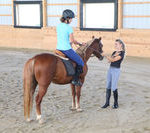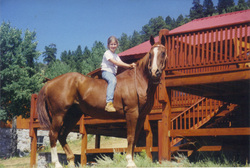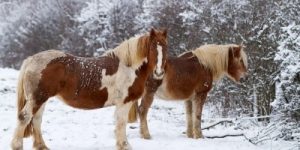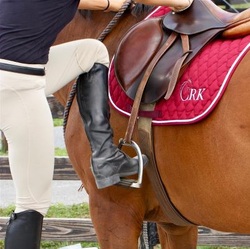To make progress, in any area of life, requires focus. Going in many different directions at once simply creates overwhelm, not real progress. But focus on one thing, and you can achieve real results.
This concept can be applied to most any area of life and is as useful for improving your riding and horsemanship as it is getting fit, or having success in your career.
I often find that my best insights regarding horsemanship come from sources focused in other fields, such as psychology, learning, business, or health.

This was once again true as I recently read a book titled “The One Thing.” This book made the case that success is about our ability to determine one important thing to focus on and do.
Of course, we can have different definitions of success in regards to riding, but that is unimportant.
You can choose your own goals, and it doesn’t matter if you want to safely enjoy trail riding on the weekends, ride a low-level dressage test, or if you have ambitions for higher level competition.
The concept in this book was that to improve, and to feel the satisfaction that we are making progress, we must prioritize – identify and focus on what matters most. When we try to do it all, practicing ten riding tips as once, learning three different disciplines, using everything we’ve ever been taught…we can end up not really improving anywhere.
The trick is to work sequentially, by figuring out what needs done first and then focusing there until a level of proficiency is reached before moving on.
The challenge is, with seemingly infinite options, what is the one thing that does matter most? How do we know when that one thing has shifted?
The key is to ask good questions.
In the book, The One Thing, a simple but genius question is proposed that can cut through overwhelming choices and help you figure out what is most important.
Here’s the question: What’s the ONE Thing I can do that will make everything else easier or unnecessary?
We can’t do everything at once, so when making a choice between reading a new book, enrolling in a course, taking more riding lessons, practicing your 20 meter circles, improving your fitness, looking for a new saddle, etc, etc. What’s the one thing you should do first that will have the biggest impact?
Asking this question, and asking it often is what will keep you on track and in focus.
Here’s how to apply this to improving your riding. You want to be more effective and feel more “at one” with your horse. You begin by envisioning a goal. Perhaps you want to feel confident cantering out on the trail, you want to ride a better leg yield, or you want to canter the whole jump course.
When you determine a goal, you begin looking for where to focus first. Start asking the question, what’s the one thing I can do that will make everything else easier or unnecessary?
A good place to start is always looking at the comfort of you and your horse. If your saddle throws you in a chair seat and pinches your horse’s wither, a better fitting saddle will make everything else easier. The first one thing could be buying a new saddle.
If your horse has long toes and is overdue for a trim, making him more comfortable and balanced will help him move better, making the ride smoother for you and again, making everything else easier. The first one thing may be as simple as calling the farrier.
If you’ve got a healthy horse and good equipment, we start thinking about training. Frameworks help direct us, I strive to provide frameworks in my courses, so there is direction to learning in any topic. There are also commonly taught frameworks, such as the classic training scale. For this example, look at the training scale consider where you’re at. The goals I provided as examples earlier all tie into the base of the scale – rhythm.
Rhythm is a cornerstone to all riding, any discipline, any style of riding, any more advanced movement from the horse, first requires rhythm. Even many riding “problems” such as a horse that won’t maintain gait, drifts to the center, or head tosses, improve when the rhythm improves.
Without a feel for and an ability to maintain, rhythm, from both horse and rider, moving on to more advanced exercises is pointless.
Rhythm could be your one thing. But what do you do next to improve it?
We’ve considered three different examples of asking the question “what’s the one thing that will make everything else easier or unnecessary”, and finding an area of focus, but now we want to make sure that one thing gets done, and fortunately, there is an easy way to do just that.
There are three steps.
We’ve already done two of these steps and considered various examples.
1. Envisioned a goal – cantering confidently through an open field, riding a great leg yield, or cantering an entire jump course
2. Identified an area of focus to get us there – a better fitting saddle, improving health of our horse, improving rhythm while riding
The third step is now to create a specific new habit, once again, the most important one, to keep us making progress in that area of focus.
To find your new habit, brainstorm a list of what you could do.
Continuing with the example of improving rhythm, what’s next?
We can brainstorm a few possibilities: developing better balance and stability as a rider (work on our posture) or refining the “go forward” cue for our horse, so we can ask for forward movement, or improving the strength and fitness of our horse.
If we ask the question of what’s the one thing that will make everything else easier or unnecessary, your answer could be any of those three, or another possibility, but let’s say that improving your balance and stability as a rider stands out, because when you ride better you will be more consistent with your cues, and will be able to ride your horse in a way that his strength and fitness does improve. In this example, better balance as a rider = everything else gets easier.
So now we can go one step further and pick a simple habit to develop.
Perhaps you could do exercises at home that will apply to our riding, or attend more lessons, or take a course to better understand what good posture is.
When questioning what to focus on first, your individual answer will vary. But here’s an example of a good habit: taking 15 min a day to do simple exercises at home that will translate to our riding can make those future lessons more beneficial and will have you in the habit of daily practice, so taking future courses will be easier too.
You’ve envisioned a goal, identified the area you need to focus on, and then chosen a specific habit to create – 15 minutes of daily riding related exercises.
Results come from focus. When we focus, we can improve. The key is to make sure we are focusing on what is most important for us.
The old Chinese proverb states that “a journey of a thousand miles starts with a single step”, and with this awareness of focusing on what is most important we have made sure that step is in the right direction.
[Tweet “Results come from focus. When we focus, we can improve. The key is to make sure we are focusing on what is most important for us.”]
Related Video: Achieve Your Riding Goals the Easy Way














17 Responses
The one habit I’m going to start is focus on relaxation in the saddle. Both before and after a ride. I ride for 30 minutes or so, five times a week. Five times a week, with a plan to relax in each ride will help.
Thanks Callie, loved your examples as they are just the right ones for me to start working on – balance, more saddle time which will build my confidence and rhythm is another one that I’ll add for myself – getting in tune with my horse.
Hi Callie,
I love this! My goal is to learn to canter and feel secure and safe. My habit will be to ride with no stirrups every week to improve my seat and balance. This will make everything easier when it comes time to canter! I think it will increase my confidence too.
Great video – thank you!
Very helpful video, Callie. Finding that one goal is the challenge. My advice to anyone under age 51 is, “Find a way to do what you love and care deeply about ASAP!” If I could be on this earth for 1,000 years, I might get it all done. 🙂
Great choice of topic, as always. Thank you Callie from down under.
And while focusing on one thing at a time, it is important to concentrate on the positive. We might have some crapy riding days , but there will always be something positive, no matter how small. That’s the one to focus on and to record in our riding diary, so when we look back , the whole journey has been a continuous improvement
Excellent video! I love that you are always learning Callie, and sharing what you learn with your online audience. I think my big goal is to have more confidence both in handling the horse on the ground (dealing with unexpected behaviors) and more confidence in the saddle (also dealing with forward or unexpected behavior). I think that is the one thing that would make all other things easier. As far as developing a daily habit, I’m sort of stumped.
This video is Just what I needed. I love to learn and try to absorb everything at once even if I’m only trying to practice one thing at a time. I just cut back my barn chore hours starting next week. I will be back to daily yoga now that I won’t be so exhausted each Day. This will improve my balance so I can give independent consistent cues.
Always enjoy your thinking “outside the (dressage) box”.
I am a green rider with and green 14year old horse. Been working on building a relationship with my horse for about 2 years…
I recently border my horse for a week with 4 riding lessons and ended up being super discouraged. “You are a green rider and you have a green horse and you should have taken lessons 2 years ago and get your horse trained by a professional….” was basically what the trainer said. Yet, she wants me to keep coming back for lessons!!
I decided to take a step back from all and think about what I need to do to help my horse to be more rhythmic ( went for lessons to help my horse to use her hind, not her front).
Her Trott is a jack-hammer Trott and yes, I can sit it, but it ultimately is not good for her.
We( Annie, my horse, and i) have a great relationship, I ride her bitless and with bareback pad and we traIL ride mostly. I trust my green horse 100%.
your video showed me, that I am on the right track. My final goal is to have Annie happily trotting rhythmically across endless fields and trails.
My focus now is to get her walking rhythmically first during liberty work and on lunge.
After she is relaxed and confident I will focus on helping her getting a rythmic and confident Trott.
So, my dear, again, thank you so much for your insight- i so much appreciate your simplicity.
Tina
I have watched all 7 of these last videos and this one gave me the advice to tie them all together because I could relate to it nd my need to focus on just one goal at a time, I can slow down and be aware of my horse and our relationship but still focus on what I need to do,( one thing at a time} to help him and help me be a better rider.
Thank you Callie for another great video. Such a great question!! I recently decided to switch from riding western to English. Totally different feel. I’m not a great rider but love to ride. Most of my riding is on my property and alone. My goal is to gain more confidence in riding in an English saddle (stop the floppy irons syndrome ) so I can fully enjoy whatever riding time I have. Barb from Wpg. Mb. Canada
In the movie “City Slickers”, Curly gives this same advice to Mitch. It made an impression on me then and I like the way you expanded on it. Very good advice!
The author of the “One Thing” book mentioned that scene – guess I need to watch the movie again!
In a world so busy around us you forget about Focus and how to get there. My goal is to Focus more on just working with my horse on the ground to improve our time in the saddle. Focusing on he & I at that moment versus what happened earlier that day. Thanks for the info to get me going in the right direction.
At first, what I could think of for a goal was to be more focused. Then, once I was there for my time with the horses, the word I could think of for a goal was “safety.” It seems it turned out that most everything I did was related to safety in one form or another. I felt like walking Sweetheart, my mentor’s blind gelding, around before riding him. I didn’t plan this ahead of time, but I felt like closing my eyes while walking him a circle around my mentor, with Sweetheart on a lead line, feeling where he was through the lead line; at the time, I didn’t know why I felt like doing this. I asked my mentor to tell me if I was about to walk into anything. At one point, she said we were starting to come close into her, so I opened my eyes and saw that we were. Thinking about it later, it seemed that he was probably wanting to come in to my mentor, and what I was doing was letting a blind horse lead me with my eyes closed! That was quite an experience, and a good one, to find that I was safe doing that.
Since injuring my knee to the point where I had to re-learn how to walk after falling off Sweetheart when I tried to get on him bareback, but he walked away and I fell to the ground, I’ve been way more cautious when mounting, and also dismounting, so I worked on that with Sweetheart.
When I was riding Sweetheart, it was for both his safety and mine, that I had to be especially aware of where the roots were on the trail to tell him “easy,” and where the frost was where it might be slippery, and where there might be something on the trail I’d have to steer him around.
I knew I wouldn’t be able to only focus, the whole time, on only one thing, as I had to be aware of the trail, what Sweetheart was doing and feeling, and my balance on his back. My mentor and I had talked about focus, and she reminded me of using “soft eyes.” Sally Swift talks about using soft eyes and hard eyes in the book Centered Riding.
(This was my latest experience with EGE, Equine Guided Education).
Thank you, Callie, for this video that prompted me to think about having a goal and focusing.
Hi Carol, so good to hear from you! I love your last comment about soft eyes, this was one of my favorite takeaways years ago when I first read Sally Swift’s book and actually, that could be a great article on it’s own…
I need to be more relaxed and not tense up while asking for the canter. I’m still trying to figure out why I do. I’m just going to step back and just try to keep myself relaxed and only get like 5 strides without bouncing. Any other ideas?
That is actually exactly what I would recommend! Take a step back and lessen the amount of strides of the canter. You can also try more of extended trot and work up to canter as well!
-Julia Burdy, CRK Training Community Manager